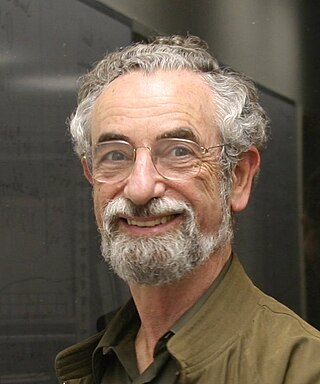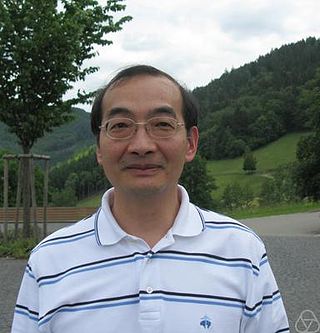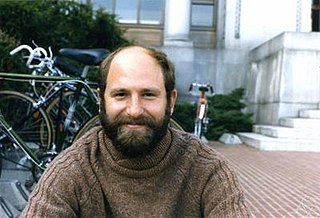Related Research Articles

In quantum mechanics, the Pauli exclusion principle states that two or more identical particles with half-integer spins cannot simultaneously occupy the same quantum state within a quantum system. This principle was formulated by Austrian physicist Wolfgang Pauli in 1925 for electrons, and later extended to all fermions with his spin–statistics theorem of 1940.
A timeline of atomic and subatomic physics.

A Luttinger liquid, or Tomonaga–Luttinger liquid, is a theoretical model describing interacting electrons in a one-dimensional conductor. Such a model is necessary as the commonly used Fermi liquid model breaks down for one dimension.

Elliott Hershel Lieb is an American mathematical physicist and professor of mathematics and physics at Princeton University who specializes in statistical mechanics, condensed matter theory, and functional analysis.

Barry Martin Simon is an American mathematical physicist and was the IBM professor of Mathematics and Theoretical Physics at Caltech, known for his prolific contributions in spectral theory, functional analysis, and nonrelativistic quantum mechanics, including the connections to atomic and molecular physics. He has authored more than 400 publications on mathematics and physics.

David Pierre Ruelle is a Belgian mathematical physicist, naturalized French. He has worked on statistical physics and dynamical systems. With Floris Takens, Ruelle coined the term strange attractor, and developed a new theory of turbulence.
In physics, the Bethe ansatz is an ansatz for finding the exact wavefunctions of certain quantum many-body models, most commonly for one-dimensional lattice models. It was first used by Hans Bethe in 1931 to find the exact eigenvalues and eigenvectors of the one-dimensional antiferromagnetic isotropic (XXX) Heisenberg model.

Alexander Leonidovich Kuzemsky is a Russian theoretical physicist.

Horng-Tzer Yau is a Taiwanese-American mathematician. He received his B.Sc. in 1981 from National Taiwan University and his Ph.D. in 1987 from Princeton University. Yau joined the faculty of NYU in 1988, and became a full professor at its Courant Institute of Mathematical Sciences in 1994. He moved to Stanford in 2003, and then to Harvard University in 2005. He was also a member of the Institute for Advanced Study in Princeton, New Jersey, in 1987–88, 1991–92, and 2003, and was a distinguished visiting professor in 2013–14.
Konrad Osterwalder is a Swiss mathematician and physicist, former Undersecretary-General of the United Nations, former Rector of the United Nations University (UNU), and Rector Emeritus of the Swiss Federal Institute of Technology Zurich. He is known for the Osterwalder–Schrader theorem.

Communications in Mathematical Physics is a peer-reviewed academic journal published by Springer. The journal publishes papers in all fields of mathematical physics, but focuses particularly in analysis related to condensed matter physics, statistical mechanics and quantum field theory, and in operator algebras, quantum information and relativity.

Huzihiro Araki was a Japanese mathematical physicist and mathematician who worked on the foundations of quantum field theory, on quantum statistical mechanics, and on the theory of operator algebras.

Robert Seiringer is an Austrian mathematical physicist.
The Lieb–Robinson bound is a theoretical upper limit on the speed at which information can propagate in non-relativistic quantum systems. It demonstrates that information cannot travel instantaneously in quantum theory, even when the relativity limits of the speed of light are ignored. The existence of such a finite speed was discovered mathematically by Elliott H. Lieb and Derek W. Robinson in 1972. It turns the locality properties of physical systems into the existence of, and upper bound for this speed. The bound is now known as the Lieb–Robinson bound and the speed is known as the Lieb–Robinson velocity. This velocity is always finite but not universal, depending on the details of the system under consideration. For finite-range, e.g. nearest-neighbor, interactions, this velocity is a constant independent of the distance travelled. In long-range interacting systems, this velocity remains finite, but it can increase with the distance travelled.

Paul Anthony Benioff was an American physicist who helped pioneer the field of quantum computing. Benioff was best known for his research in quantum information theory during the 1970s and 80s that demonstrated the theoretical possibility of quantum computers by describing the first quantum mechanical model of a computer. In this work, Benioff showed that a computer could operate under the laws of quantum mechanics by describing a Schrödinger equation description of Turing machines. Benioff's body of work in quantum information theory encompassed quantum computers, quantum robots, and the relationship between foundations in logic, math, and physics.

Steven Morris Zelditch was an American mathematician, specializing in global analysis, complex geometry, and mathematical physics.
In many-body physics, most commonly within condensed-matter physics, a gapped Hamiltonian is a Hamiltonian for an infinitely large many-body system where there is a finite energy gap separating the ground space from the first excited states. A Hamiltonian that is not gapped is called gapless.
Gian Michele Graf is a Swiss mathematical physicist.
Reinhard F. Werner is a German physicist, and Professor at the Institute of Theoretical Physics at the Leibniz Universität Hannover.
In physics, stability of matter refers to the problem of showing rigorously that a large number of charged quantum particles can coexist and form macroscopic objects, like ordinary matter. The first proof was provided by Freeman Dyson and Andrew Lenard in 1967–1968, but a shorter and more conceptual proof was found later by Elliott Lieb and Walter Thirring in 1975.
References
- ↑ biographical information from American Men and Women of Science, Thomson Gale 2004
- ↑ Bruno Leo Zulma Nachtergaele at the Mathematics Genealogy Project
- ↑ Nachtergaele, Bruno; Yau, Horng-Tzer (2002). "Derivation of the Euler equations from many-body quantum mechanics". Proceedings of the ICM, Beijing 2002. Vol. 3. pp. 467–476. arXiv: math-ph/0210036 .